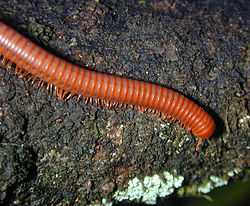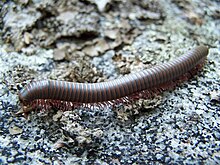Millipede
| Giant Millipede | |
|---|---|

| |
| Rusty millipede (Trigoniulus corallinus) | |
| Scientific classification | |
| Kingdom: | |
| Phylum: | |
| Subphylum: | |
| Class: | Diplopoda |
| Subclasses, orders and families | |
|
See text | |
Millipedes (Class Diplopoda, previously also known as Chilognatha) are arthropods that have two pairs of legs per segment (except for the first segment behind the head which does not have any appendages at all, and the next few which only have one pair of legs). Each segment that has two pairs of legs is a result of two single segments fused together as one. Most millipedes have very elongated cylindrical bodies, although some are flattened dorso-ventrally, while pill millipedes are shorter and can roll into a ball, like a pillbug. Millipedes are detritivores and slow moving. Most millipedes eat decaying leaves and other dead plant matter, moisturising the food with secretions and then scraping it in with the jaws. However they can also be a minor garden pest, especially in greenhouses where they can cause severe damage to emergent seedlings. Signs of millipede damage include the stripping of the outer layers of a young plant stem and irregular damage to leaves and plant apices.
This class contains around 10,000 species. There are 13 orders and 115 families.
The giant African millipede (Archispirostreptus gigas) is the largest species of millipede.
Millipedes can be easily distinguished from the somewhat similar and closely related centipedes (Class Chilopoda), which move rapidly, and have a single pair of legs for each body segment.
Prehistory
This class of arthropod is thought to be among the first animals to have colonised land during the Silurian geologic period. These early forms probably ate mosses and primitive vascular plants. The oldest known land creature, Pneumodesmus newmani, was a 1 centimetre-long millipede.[2]
Characteristics


The millipede's most obvious feature is its large number of legs. In fact, its name is a compound word formed from the Latin roots milli ("thousand") and ped ("foot"). Despite their name, these creatures do not have a thousand legs, although the rare species Illacme plenipes have up to 750 [3]. However, common species have between 80 and 400 legs.
Having very many short legs makes millipedes rather slow, but they are powerful burrowers. With their legs and body length moving in a wavelike pattern, they easily force their way underground head first. They also seem to have some engineering ability, reinforcing the tunnel by rearranging the particles around it.Their bodies have segmented sections which makes them move in a wave-like form.
The head contains a pair of sensory organs known as the Tömösváry organs. These are found just posterior and lateral to the antennae, and are shaped as small and oval rings at the base of the antennae. They are probably used to measure the humidity in the surroundings, and they may have some chemoreceptory abilities too. Millipede eyes consist of a number of simple flat lensed ocelli arranged in a group on the front/side of the head. Many species of millipedes, such as cave-dwelling millipedes, have secondarily lost their eyes.
Male millipedes can be differentiated from female millipedes by the presence of one or two pairs of legs modified into gonopods. These modified legs are used to transfer sperm packets to the female during copulation. [4]
According to Guiness World Records the African Giant Black Millipede can grow to 38.6cm (15.2 in).[5]
Defense mechanisms
Due to their lack of speed and their inability to bite or sting, millipedes' primary defense mechanism is to curl into a tight coil — protecting their delicate legs inside an armoured body exterior. Many species also emit poisonous liquid secretions or hydrogen cyanide gas through microscopic pores along the sides of their bodies as a secondary defense [6][7][8]. Some of these substances are caustic and can burn the exoskeleton of ants and other insect predators, and the skin and eyes of larger predators. Lemurs have been observed intentionally irritating millipedes in order to rub the chemicals on themselves to repel insect pests. [citation needed]
As far as humans are concerned, this chemical brew is fairly harmless, usually causing only minor effects on the skin, the main effect being discoloration, but other effects may also include pain, itching, local erythema, edema, blisters, eczema, and occasionally cracked skin [7][9][10][11]. Eye exposures to these secretions causes general eye irritation and potentially more severe effects such as conjunctivitis and keratitis [12]. First aid consists of flushing the area thoroughly with water; further treatment is aimed at relieving the local effects.
Classification
The living members of the Diplopoda are divided into fifteen orders in three subclasses [13]. The basal subclass Penicillata contains 160 species whose exoskeleton is not calcified, and which are covered in setae or bristles. All other milipedes belong to the Chilognatha in the strict sense.
The subclass Pentazonia contains the short-bodied pill millipedes, which are capable of rolling themselves into a ball ("volvation"). The subclass Helminthomorpha contains the great majority of the species [14][15].
The subgroups of millipedes in phylogenetic sequence, from most basal to most advanced, are:
- Basal genus Eileticus (fossil)
- Subclass Penicillata Latreille, 1831
- Order Polyxenida Lucas, 1840
- Subclass Arthropleuridea (tentatively placed here; fossil)
- Subclass Zosterogrammida Wilson, 2005 (fossil)
- Subclass Pentazonia Brandt, 1833
- Basal genus Amynilyspes (fossil)
- Superorder Limacomorpha
- Order Glomeridesmida Latzel, 1884
- Superorder Oniscomorpha
- Order Glomerida Leach, 1814
- Order Sphaerotheriida Brandt, 1833
- Family Sphaerotheriidae Koch, 1847
- Family Sphaeropoeidae Brölemann, 1913
- Subclass Archipolypoda Scudder, 1882
- Subclass Helminthomorpha Pocock, 1887
- Superorder Pleurojulida Schneider & Werneburg, 1998 (fossil)
- Superorder Colobognatha (paraphyletic?)
- Order Polyzoniida Gervais, 1844
- Order Platydesmida DeSaussure, 1860
- Order Siphonophorida Hoffman, 1980
- Superorder "Merocheta"
- Order Polydesmida Pocock, 1887
- Superorder Nematophora
- Basal genus Hexecontasoma (fossil)
- Order Callipodida Bollman, 1893
- Order Chordeumatida Koch, 1847
- Order Stemmiulida Pocock, 1894
- Superorder Diplocheta
- Order "Xyloiuloida" Cook, 1895 (fossil)
- Order Julida Brandt, 1833
- Order Siphoniulida Cook, 1895
- Order Spirobolida
- Order Spirostreptida
Gallery
-
Harpaphe haydeniana, a species from the Pacific Northwest of North America
-
Polydesmus angustus, a European species
-
Glomeris marginata, a European pill millipede
-
The giant millipede Archispirostreptus gigas mating
-
Species africanus autintous of African giant millipede from Volta region in Ghana
-
An Indian species from BRT Wildlife Sanctuary in South India
References
- ^ "Diplopoda DeBlainville in Gervais, 1844 (Class)". SysTax. Universität Ulm, Ruhr-Universität Bochum. Retrieved 2007-08-15.
- ^ "Fossil millipede found to be oldest land creature", CNN (from Reuters), 27 January 2004 (link)
- ^ "Most leggy millipede rediscovered". BBC News. 2006-06-08.
- ^ A.Minelli (2005) "Non-systemic metamorphosis: millipede gonopods as a model system" http://www.ricercaitaliana.it/prin/dettaglio_completo_prin_en-2005055508.htm
- ^ Guinness World Records - Natural World - Creepy Crawlies - Largest Millipede
- ^ Murray S. Blum & J. Porter Woodring (1962). "Secretion of benzaldehyde and hydrogen cyanide by the millipede Pachydesmus crassicutis (Wood)". Science. 138 (3539): 512–513. doi:10.1126/science.138.3539.512. PMID 17753947.
{{cite journal}}: Unknown parameter|quotes=ignored (help) - ^ a b G. Mason, H. Thompson, P. Fergin & R. Anderson (1994). "Spot diagnosis: the burning millipede". Medical Journal of Australia. 160: 718–726.
{{cite journal}}: Unknown parameter|quotes=ignored (help)CS1 maint: multiple names: authors list (link) - ^ Yasumasa Kuwahara, Hisashi Ômura, Tsutomu Tanabe (2002). "2-Nitroethenylbenzenes as natural products in millipede defense secretions". Naturwissenschaften. 89 (7): 308–10. doi:10.1007/s00114-002-0328-9. PMID 12216861.
{{cite journal}}: Unknown parameter|quotes=ignored (help)CS1 maint: multiple names: authors list (link) - ^ S. Shpall & I. Frieden (1991). "Mahogany discoloration of the skin due to the defensive secretion of a millipede". Pediatric Dermatology. 8 (1): 25–27. doi:10.1111/j.1525-1470.1991.tb00834.x. PMID 1862020.
{{cite journal}}: Unknown parameter|quotes=ignored (help) - ^ A. Radford (1976). "Giant millipede burns in Papua New Guinea". Papua New Guinea Medical Journal. 18 (3): 138–41. PMID 1065155.
{{cite journal}}: Unknown parameter|quotes=ignored (help) - ^ A. Radford (1975). "Millipede burns in man". Tropical and Geographical Medicine. 27 (3): 279–287. PMID 1103388.
{{cite journal}}: Unknown parameter|quotes=ignored (help) - ^ B. Hudson & G. Parsons (1997). "Giant millipede 'burns' and the eye". Transactions of the Royal Society of Tropical Medicine and Hygiene. 91 (2): 183–185. doi:10.1016/S0035-9203(97)90217-0. PMID 9196764.
{{cite journal}}: Unknown parameter|quotes=ignored (help) - ^ "Diplopoda". Integrated Taxonomic Information System.
- ^ Julián Bueno-Villegas, Petra Sierwald & Jason E. Bond. "Diplopoda". In J. L. Bousquets & J. J. Morrone (ed.). Biodiversidad, taxonomia y biogeografia de artropodos de Mexico (PDF). pp. 569–599.
- ^ Rowland M. Shelley. "Millipedes". American Tarantula Society.





